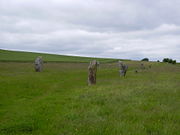.gif)
Avenue (archaeology)
Encyclopedia

British Isles
The British Isles are a group of islands off the northwest coast of continental Europe that include the islands of Great Britain and Ireland and over six thousand smaller isles. There are two sovereign states located on the islands: the United Kingdom of Great Britain and Northern Ireland and...
but they are concentrated in the centre and south of England
England
England is a country that is part of the United Kingdom. It shares land borders with Scotland to the north and Wales to the west; the Irish Sea is to the north west, the Celtic Sea to the south west, with the North Sea to the east and the English Channel to the south separating it from continental...
.
Most are either short and straight (Type I, less than 800m long), or long and curving (Type II, up to 2.5 km). It has been noted that they often link stone circle
Stone circle
A stone circle is a monument of standing stones arranged in a circle. Such monuments have been constructed across the world throughout history for many different reasons....
s with rivers. They are a common element to Bronze Age
Bronze Age
The Bronze Age is a period characterized by the use of copper and its alloy bronze as the chief hard materials in the manufacture of some implements and weapons. Chronologically, it stands between the Stone Age and Iron Age...
ritual landscapes.
Avenues are identified through their earthworks or using aerial archaeology
Aerial archaeology
Aerial archaeology is the study of archaeological remains by examining them from altitude.The advantages of gaining a good aerial view of the ground had been long appreciated by archaeologists as a high viewpoint permits a better appreciation of fine details and their relationships within the wider...
as their parallel side features can be seen stretching over some distance. In most examples, it is the association of the avenue with other contemporary monuments that provides diagnosis. Avenues differ from cursus
Cursus
thumb|right|250px|[[Stonehenge Cursus]], Wiltshirethumb|right|250px|[[Dorset Cursus]] terminal on Thickthorn Down, DorsetCursus was a name given by early British archaeologists such as William Stukeley to the large parallel lengths of banks with external ditches which they thought were early Roman...
monuments, in that the latter also have earthworks at their terminal ends and have no upright stone or timber alignments.
Avenues are thought to have been ceremonial or processional paths and to be of early Bronze Age date. They seem to have been used to indicate the intended route of approach to a particular monument.
Examples include the Stonehenge Avenue
Stonehenge Avenue
Stonehenge Avenue is an ancient avenue marked as a UNESCO World Heritage Site. Discovered in the 18th century, it measures nearly 3 kilometers, connecting Stonehenge with the River Avon...
, the Beckhampton Avenue
Beckhampton Avenue
The Beckhampton Avenue a curving prehistoric avenue of stones that ran broadly south west from Avebury towards The Longstones at Beckhampton in the English county of Wiltshire. It probably dates to the late Neolithic and early Bronze Age....
at Avebury
Avebury
Avebury is a Neolithic henge monument containing three stone circles which is located around the village of Avebury in Wiltshire, south west England. Unique amongst megalithic monuments, Avebury contains the largest stone circle in Europe, and is one of the best known prehistoric sites in Britain...
, West Kennet Avenue and that at Thornborough
Thornborough Henges
The Thornborough Henges is an unusual ancient monument complex that includes the three aligned henges that give the site its name. The complex is located near the village of Thornborough, close to the town of Masham in North Yorkshire, England. The complex includes many large ancient structures...
.
External links
- Gazetteer of Avenues at the Megalithic Portal

